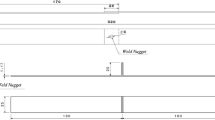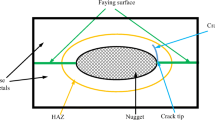Abstract
The main aim of the project was to evaluate the influence of combined effects of fatigue loading and exposure to cyclic corrosion testing on the corrosion and the fatigue resistances of coated steel-based materials joined by resistance spot welding. Seven steel-based materials including cold rolled mild steels, high-strength steels, and press-hardened steels (PHS) were selected and provided by steel suppliers with different surface coatings for resistance spot welding. Panels were joined using conventional resistance spot welding in both lap-shear and T-peel designs. Joined samples were painted by e-coating following the industrial process. Metallographic characterization of the steel materials revealed that microstructures and metallic coating composition and thickness were as expected. Cross section of spot welds showed good quality and typical evolutions of hardness. Tensile tests and fatigue tests were performed on reference samples (fatigue in “air,” i.e., nonexposed to corrosion) leading to typical SN-lines as described in part I of this paper. The results were used to evaluate the influence of corrosion on tensile strength of the joined samples. Fatigue tests performed on combined and alternating corrosion and fatigue revealed that fatigue life is affected by extent of corrosion near the spot weld, with a reduction of the fatigue life at higher applied load and slight increase for lower load, compared to tests “in air.” This phenomenon was not observed for lap-shear configuration in alternated fatigue-corrosion mode.























Similar content being viewed by others
Abbreviations
- a, b:
-
Regression parameters (linear regression)
- BM:
-
Base material
- C:
-
Fatigue capacity
- CRS:
-
Cold rolled steel
- d (mm):
-
Nugget diameter
- \( \widehat{F} \) (N, kN):
-
Maximum force level of load range
- \( {\widehat{F}}^{*} \) (N, kN):
-
Projected load level
- HAZ:
-
Heat-affected zone
- HSS:
-
High-strength steel
- HV0,5:
-
Vickers hardness (Test load 4903 N)
- IF:
-
Interfacial failure
- k:
-
Slope exponent of Basquin equation
- κ:
-
Risk factor at confidence limit
- LS:
-
Lap-shear specimen
- N:
-
Cycles
- n:
-
Number of specimen in sample
- N avg :
-
Average cycle number for projection of fatigue capacity
- N f :
-
Cycles to failure
- PF:
-
Plug failure
- PHS:
-
Press hardened steel
- PIF:
-
Plug interfacial failure
- r:
-
Correlation coefficient
- R:
-
R-ratio of stress range
- RD:
-
Rolling direction
- ReH, ReL (MPa):
-
Upper/lower yield point
- RSW:
-
Resistance spot welding
- s:
-
Standard deviation
- SCx:
-
NaCl concentration in x %
- SFx:
-
Frequency x of salt spray application per week
- T:
-
Scatter factor
- t, t1, t2 (mm):
-
Sheet thickness
- TD:
-
Transverse to rolling direction
- TP:
-
T-peel specimen
- TS (MPa):
-
Tensile stress
- Tx:
-
Temperature in x °C
- YPE (%):
-
Yield plateau elongation
- YS (MPa):
-
Yield stress
- i:
-
ith value
- *:
-
Projected value
- 10 %, 90 %:
-
Probability
- N:
-
Load cycles
- s:
-
Surveillance (reliability) or stress
- C:
-
Fatigue capacity
References
2013 VDA 233-102, cyclic corrosion testing of materials and components in automotive construction
D. Thierry, F. Vucko, B. Weber, L. Dosdal, G. Luckeneder, T. Bschorr, K. Rother: Fatigue behavior of spot welded joints in air and under corrosive environments. Part I: materials, specimen and test results in air. Revised version of IIW-Doc. XIII-2628-16, Welding In the World (submitted)
voestalpine Stahl GmbH Linz: AutoFatCor Report on corrosion properties of joined samples. Deliverable D5. 12/09/2013. Research Fund for Coal and Steel; Grant Agreement No RFSR-CT-2011-00021
Institut de la Corrosion: Report on the influence of climatic parameters on the combined corrosion-fatigue performance of joined samples. Deliverable D7. 18/03/2015. Research Fund for Coal and Steel; Grant Agreement No RFSR-CT-2011-00021
D Thierry et al.: Combined corrosion and fatigue strength of joined materials for body-in-white and structural automotive applications design. Final report v3. 07/03/2015. Research Fund for Coal and Steel; Grant Agreement No RFSR-CT-2011-00021
Annual report 4 issued 30/03/2015: Research Fund for Coal and Steel; Grant Agreement No RFSR-CT-2011-00021
LeBozec N, Blandin N, Thierry D (2008) Accelerated corrosion tests in the automotive industry: a comparison of the performance towards cosmetic corrosion. Mater Corros 39-11:889–894
Du ML, Chiang FP, Kagwade SV, Clayton CR (1998) Damage of Al 2024 alloy due to sequential exposure to fatigue, corrosion and fatigue. Int J Fatigue 20-10:743–748
Acknowledgments
Funding of the project by the European Commission, Research Program of the Research Fund for Coal and Steel, Technical Group: TGS7 Steel products and applications for automobiles, packaging and home appliances under the Grant Agreement No. RFSR-CT-2011-00021 is greatly acknowledged.
Author information
Authors and Affiliations
Corresponding author
Additional information
Recommended for publication by Commission XIII - Fatigue of Welded Components and Structures
Rights and permissions
About this article
Cite this article
Thierry, D., Vucko, F., Luckeneder, G. et al. Fatigue behavior of spot-welded joints in air and under corrosive environments. Weld World 60, 1231–1245 (2016). https://doi.org/10.1007/s40194-016-0367-z
Received:
Accepted:
Published:
Issue Date:
DOI: https://doi.org/10.1007/s40194-016-0367-z




